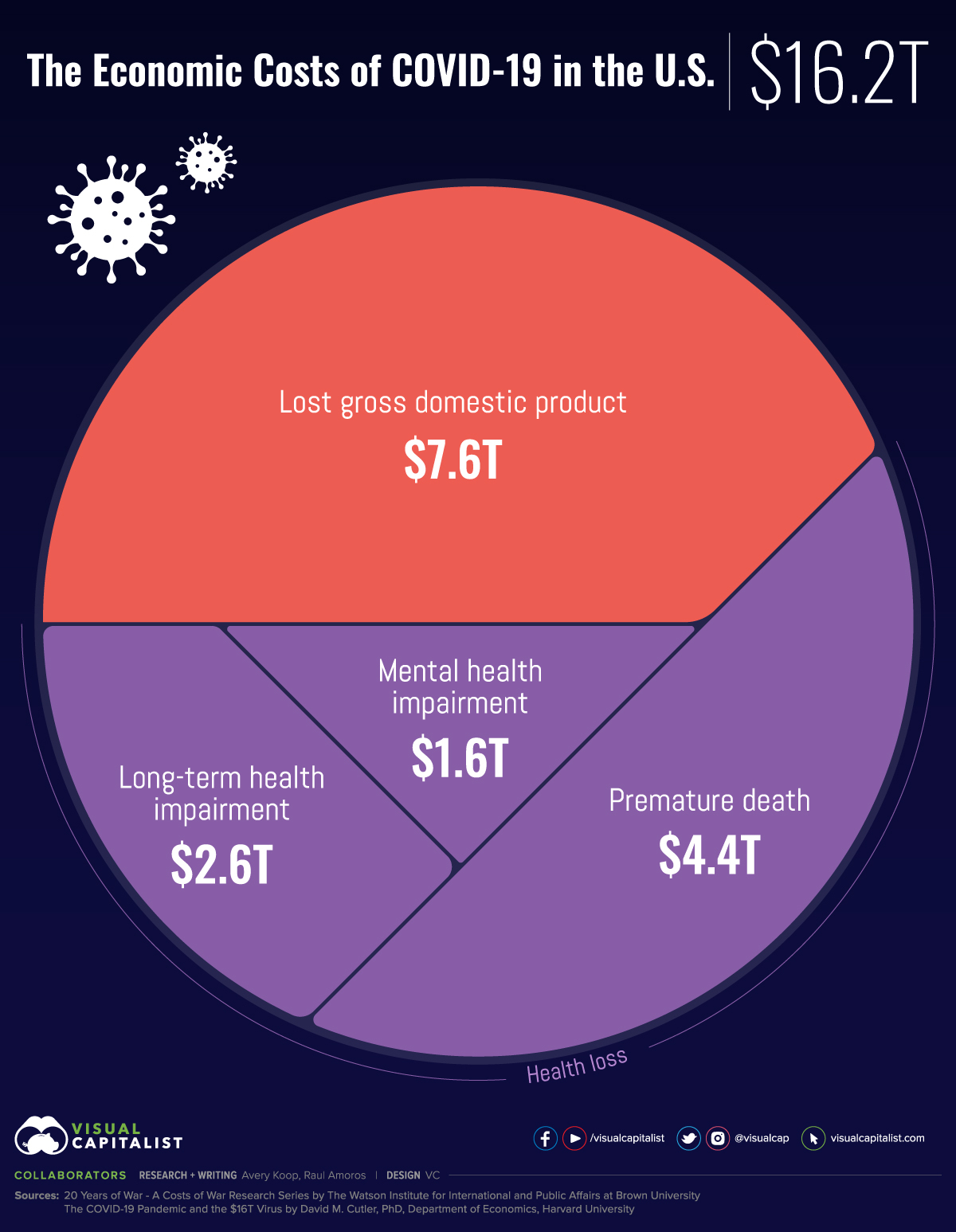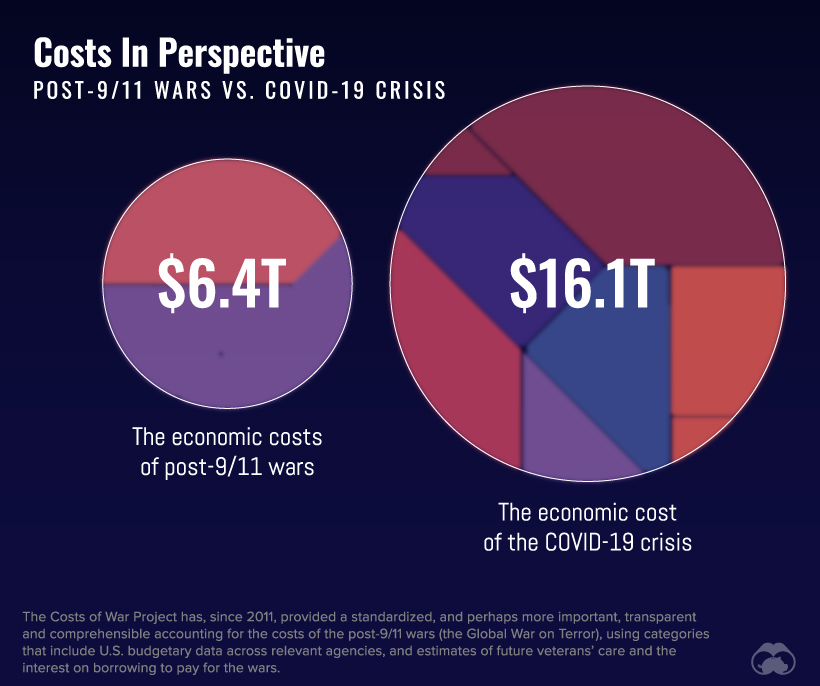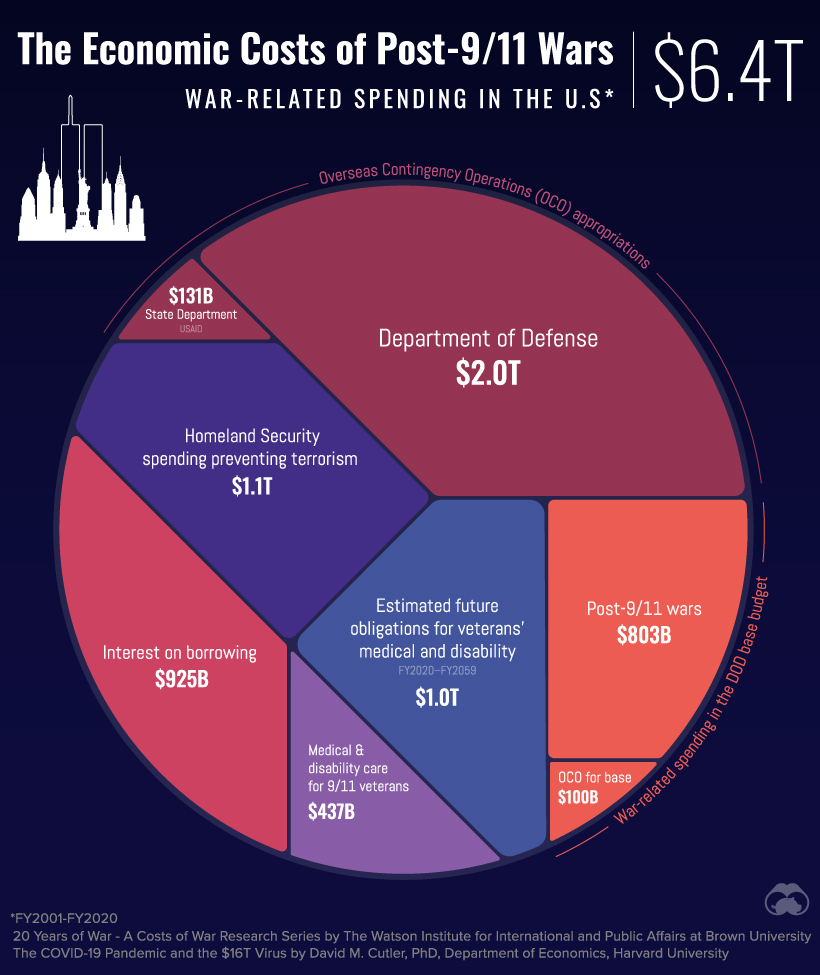Putting The Cost Of COVID-19 In Perspective

Putting the Economic Cost of COVID-19 in Perspective
When it comes to the toll on human life, mental well-being, and any long-term complications, the true cost of COVID-19 can be difficult to quantify.
That said, from a purely economic angle, researchers can and do examine these things—as well as economic data like unemployment and lost GDP, to assign dollar figures to the pandemic.
Using data from a study out of Harvard University, these visualizations focus on putting the economic cost of COVID-19 in the U.S. in perspective. To help us understand the immense price associated with a pandemic, the study looked at other comparables like the costs of running America’s longstanding war on terror.

The Cost of COVID-19
Since the pandemic took hold in the U.S. in March 2020, job loss has been one of the most significant consequences. Unemployment claims in the U.S. have recently reached a total of 60 million, while lost GDP is estimated to be around $7.6 trillion.
Unemployment, uncertainty, lost loved ones, and lost social connections, have led to spikes in depression and anxiety. In April 2020, around 40% of U.S. adults reported having at least one of these mental illnesses. Based on the sheer number of people struggling, the cost of mental health impairment could be as high as $1.6 trillion, according to these researchers.
| Category | Cost (Billions) |
|---|---|
| Lost Gross Domestic Product (GDP) | $7,592 |
| Premature Death | $4,375 |
| Long-Term Health Impairment | $2,572 |
| Mental Health Impairment | $1,581 |
| Total | $16,120 |
The economic value of human life can be put in terms of ‘statistical lives’, a notion used in both American and global health policy. While human life is priceless, the value tied to one using this metric sits between $7-$10 million. Even when using the lower end of the scale, the cost of premature death due to COVID-19 is estimated to be $4.4 trillion.
Finally, when looking at the long-term healthcare costs that could impact people who contract COVID-19, the price comes out to almost $2.6 trillion. These costs will go on for decades as certain lifelong conditions can emerge out of COVID-19, like respiratory and cardiovascular issues.
Many of these conditions could also end up causing premature deaths, drawing out the total cost of COVID-19 even further.
The Cost of War

Both a global pandemic and a war have long-term health consequences and are extremely pricey.
The estimated cost of the post-9/11 wars rises to over $6 trillion. This is measured by the spending of the Department of Defense, the Department of State, and USAID. The estimate also takes into consideration current and future spending on medical and disability care for veterans, the cost of war appropriations and spending, the estimated interest on borrowing for different departments, and the spending the Department of Homeland Security has done in order to prevent and respond to terrorism.
| Category | Cost (Billions) |
|---|---|
| Department of Defense | $1,959 |
| State Department/USAID | $131 |
| Estimated Interest on Borrowing for DOD and State Dept OCO Spending | $925 |
| Estimated Increases to DOD Base Budget Due to Post-9-11 Wars | $803 |
| "OCO for Base” a new category of spending in FY2019 and FY2020 | $100 |
| Medical and Disability Care for Post-9/11 Veterans | $437 |
| Homeland Security Spending for Prevention and Response to Terrorism | $1,054 |
| Total War Appropriations and War-Related Spending through FY 2020 | $5,409 |
| Estimated Future Obligations for Veterans Medical and Disability FY2020 –FY2059 | $1,000 |
| Total War-Related Spending through FY2020 and Obligations for Veterans | $6,409 |
Medical and disability care for veterans from the post-9/11 wars specifically comes out to $437 billion, with estimated future obligations for their care going up to $1 trillion.
The increases to the Department of Defense’s budget was $803 billion thanks to the post 9/11 wars, and the Department of Homeland Security has spent more $1.05 trillion on terrorism prevention and response.
While the costs associated with war are immense, and while the consequences of fighting in a war are usually lifelong, the estimated price is still about $10 trillion cheaper than the cost of COVID-19 in the United States.
Throwing Money at the Problem?
The short-term solution to COVID-19 seems to be vaccine investment, with the U.S. currently purchasing more than one billion doses. Vaccines could spell the return to a more normal life, both in terms of physical health and the health of the economy.
While economic recovery is on the horizon, the U.S—and other nations around the globe—will continue to pay the cost of COVID-19 for years to come.
Disclosure: This material has been distributed for informational purposes only. It is the opinion of the author and should not be considered as investment advice or a recommendation of any ...
more


